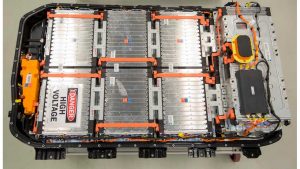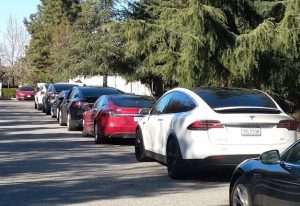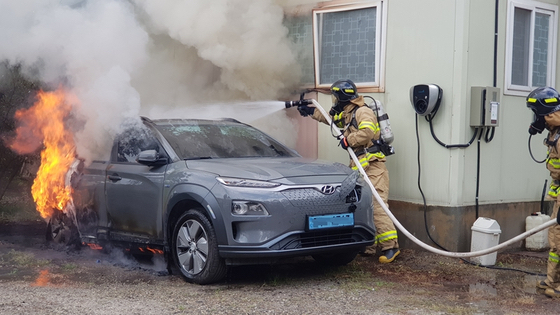The infamously exploding Ford Pinto was recalled because of a design defect with the Pinto. That particular car. But cars – as such – weren’t defective, so only the Pinto was recalled for its proclivity to burn when hit from behind.
But electric cars have this defect designed into them.
All of them.
And unlike with the Pinto, you don’t have to get hit – or hit anything – for an electric car to burn. The things can – and have – caught fire when parked. Actually, “caught” is not the right word to describe what happens.
Spontaneous combustion is better.
It is because of the nature/design of electric car batteries, which are not like the small 12 volt battery that starts the engine of a not-electric car. That battery is generally lead-acid and fires are very rare because it requires at least two predicates: A spark – as caused by jumper cables contacting the battery’s terminals – and leaking hydrogen gas. If both of those predicates aren’t present, a 12 volt starter battery fire is highly improbable.
It’s almost unheard of nowadays because almost all 12 volt starter batteries made since the ‘90s are sealed. Hence, no gas can escape, all-but-eliminating the possibility of a fire ignited by a spark during a jump-start operation.
You can break the case of a 12 volt starter battery and it will leak – but not burn.
Electric car batteries, on the other hand, are very high voltage batteries – 400 volts is typical; 800 volts is becoming common – and they are fire-prone by design.
A process called thermal runaway can trigger a fire without a spark – or an impact. This most commonly happens when the electric car is being charged – and it is why electric car fast-charging is always a potential fire problem.
With every electric car.
Which is why “fast” is slow – vs. refueling, which takes less than five minutes without any risk of fire from the pumping of fuel. But the “pumping” of volts is always a fire risk; it causes the battery to get hot and that can lead not just to a fire but a very hot and hard to extinguish fire.
Sometimes, it takes several tries to extinguish the fire, which restarts itself. Roasted EVs have re-roasted themselves after the melted and presumably extinguished hulk was dragged onto a flatbed. Or at the junkyard – where special fire-containment systems are being installed to deal with this problem.
This is why “fast” charging takes 20-30 minutes or longer – and also why the charge is not to “full.” When you “fast” charge an EV, you only partially charge it – to about 80 percent of capacity in most cases. This is a necessary precautionary measure to reduce the risk of a fire.
Which also reduces the EV’s range – and so necessitates another (and sooner) recharge.
But it does not eliminate the risk, which is inherent. And which will in all probability increase as “fast” charging increases. Which is inherently more risky, as far as risking thermal runaway, than letting the battery charge slowly – as via plugging in to low-voltage household (120 volt) current.
The problem with that, of course, is that it takes several (6-12) hours to recharge an electric car’s batteries that way and most people do not want to wait that long or plan their lives around recharging. It hasn’t been as obvious an issue – yet – because electric cars are still only about 1 percent of the total number of cars in service and most of the people who currently own electric cars are zealous about electric cars – i.e., people willing to put up with the car’s deficits because they are so enamored of the cars themselves.
But most people who just want a car to work are not likely to be willing to tolerate such waits and will insist on “fast” – and faster charging, in order to not have to wait. And they will be “fast” charging more frequently.
Which will almost certainly increase the number of thermal runaway fires and deaths. There will also be more accidents involving electric cars as more and more electric cars are force-fed into the pipeline, as via the Harris-Biden administration’s “mandates” (and determination to install more “fast” chargers).
There is also a higher fire risk when an EV hits something – or is hit by something – for the same thermal runaway reason. The battery pack’s case is damaged or the internal cells are compromised. The materials within short circuit and – voila – flambee.
This risk is – again – inherently higher with EVs because it does not take a spark to ignite the fire, as it does with a gasoline fire. A non-electric car can be hit hard enough to deform or even puncture its gas tank and – even if there is a leak, a fire is not inevitable unless there is also a spark.
But an EV battery can combust simply as a result of being hit. And it is – again – inherently more likely to be damaged in any accident because the battery is everywhere. Unlike a gas tank – which is usually located ahead of the rear axle and thus both isolated to that part of the car and protected by the surrounding structure of the car – an EV’s battery is spread out over most of the car’s floorpan, necessary because of its huge size (a Tesla 3 has 1,000 pounds of batteries). That means a frontal or side or rear impact can damage the battery and trigger a fire whereas with a gas tank, the car has to be hit in the rear, usually, to cause any damage to the tank.
And even then, you still need a spark.
EV battery fires are the most under-reported and reluctantly recalled design defect in the history of the car.
The latest recall is a big one, though.
The National Highway Traffic Safety Administration (NHTSA) which is the federal “safety” apparat – has finally had to do something about self-immolating Hyundai Kona and Ioniq electrc cars. The fire risk – from thermal runaway – is so great that almost 80,000 of these things are being recalled and NHTSA exhorts owners that in the meanwhile, “the safest place to park them is outside and from homes and structures.”
But the fulsome scurvy truth is that all EVs should be recalled. Because they are all fire-prone, by design.
Not that it matters. “Safety” is just a bogey, selectively applied – when it suits. And right now, it does not suit – because electric cars are the vehicle for getting the masses out of cars by making cars too expensive for most people to own or – at the very least – getting the mobility of the masses under strict control, which EVs are perfectly suited for as they are electronically as well as remotely controllable cars.
What’s a few eggs broken when you’re making such a tasty omelette?
. . .
Got a question about cars, Libertarian politics – or anything else? Click on the “ask Eric” link and send ’em in!
If you like what you’ve found here please consider supporting EPautos.
We depend on you to keep the wheels turning!
Our donate button is here.
If you prefer not to use PayPal, our mailing address is:
EPautos
721 Hummingbird Lane SE
Copper Hill, VA 24079
PS: Get an EPautos magnet or sticker or coaster in return for a $20 or more one-time donation or a $10 or more monthly recurring donation. (Please be sure to tell us you want a magnet or sticker or coaster – and also, provide an address, so we know where to mail the thing!)
My eBook about car buying (new and used) is also available for your favorite price – free! Click here. If that fails, email me at EPeters952@yahoo.com and I will send you a copy directly!












For a couple years, every time you got on a plane they would tell you to turn off your mobile device. And then they would say, “Unless you are using a Samsung Note. If you are, you must give it to us, and we’ll remove it from the plane, pronto.”
That phone uses the same batteries as the Tesla.
At least the lithium-ion fires can be extinguished with a normal fire extinguisher. Regular lithium and a few other types need a big-ass specialized class D extinguisher to put out. A 1000 lb lithium battery fire would be unstoppable otherwise.
By some magical decree, the Psychopaths In Charge have banished reality. But only their highly profitable psychotropics are suitable drugs to accomplish such. After all, you’re too stupid to choose your own. Just as you’re too stupid to decide which car you want to drive. You’re too stupid to understand that a possibly slightly more dangerous than ordinary virus demands us all to participate in the biggest medical experiment in history. You’re too stupid to understand that just because CO2 doesn’t cause climate change doesn’t mean CO2 doesn’t cause climate change. You’re too stupid to understand that even though gender reassignment is child abuse, doesn’t mean that it is child abuse. Salvador Dali for President!!
If you want high performing batteries, you have to use chemicals that use small ions in a sparse crystal structure, so they can hop around easily (to create electrical potential energy from one side to the other).
In other words, for better performing batteries you need to use chemicals that are fundamentally UNSTABLE. The “better” the battery (in terms of charge/discharge capability with low memory) the more unstable the material is going to be. There are really no two ways about it, and manufacturers are walking a very fine line.
Don’t like the way it is? Sorry, the periodic table would like to have a word with you. Can’t argue with physics.
Eric,
I have a couple of random thoughts here. One, it seems like it’s mainly the Tesla Model S that goes up in flames; one doesn’t hear about the other models, particularly the Model 3 and the Model Y, both of which use a different Li-Ion cell than the S and the X do.
Two, one doesn’t hear about other makes of EVs going up. When was the last time you heard of a Chevy Bolt or Nissan Leaf going up? I know that the Hyundai Ioniq was recalled, but most other EV makes haven’t had the self immolation problem that seems to affect mainly the Tesla Model S.
Finally, safe battery packs that can take a hit can be built. Formula E has them. If you’ve ever seen a Formula E race, they’re rougher than NASCAR! Even though they’re single seat, open wheel cars, they bump, bang, and often crash on the tight, temporary street circuits on which they race; I have yet to see one go up after a wreck. The battery is robustly constructed, and it’s located between the driver and the rear wheels. Perhaps location has something to do with it?
I’ve never heard of a charging FE race car going up, either. Since the cars are put away in their temporary garages overnight, they could burn down the garage. AFAIK, that’s never happened. There’d be no way to cover that up, because the all the temporary garages, which are all adjacent to one another, would go up. Also, there’d be problems running the race.
If EV makers want to solve the fiery battery problem, they should consult Formula E. BTW, out of all the auto makers involved in FE (and that’s most of them, including the four major, German marques), Tesla, Hyundai, GM, and Ford are conspicuously absent.
Those are my random thoughts on this.
Methinks Elon really likes to make exploding vehicles; notice the last couple of Space-X rockets blew up spectacularly when “landing”. They want to offer rides into space on those things? Aside from the fact that a ticket is insanely expensive it would be a helluva way to check out of your life.
The explosion of a landing first stage wouldn’t affect those riding in to space, as it would’ve separated from the 2nd stage and the capsule. The 1st stage is used to blast off the pad, accelerate, and get close to orbit; once done, it’s jettisoned, and it returns either to land or a drone ship. In any case, the astronauts aren’t endangered. Now, if it blows up BEFORE stage separation, that’s a different story!
SpaceX figured out a way to bring the first stage back, so they could re-use it. Throwing away the whole rocket is wasteful; if you can save and re-use all or part of it, that’s money saved.
Santa Claus isn’t the only one who has a list of who’s naughty and nice: Uncle Sam has one too.
What’s more, people and organizations on Uncle’s “nice” list get a pass for things that people and organizations on Uncle’s “naughty” list get crucified for. Kinda like the Orange Fail got raked over the coals for making a remark about a certain lewd act that Slick Willie and Ted the Swimmer actually committed.
Because EVs are on Uncle’s “nice” list:
-The NHTSA and NTSB overlook those unfortunate events in which EVs auto-da-fe and barbecue people, not to mention their self destructive auto pilots.
-The EPA overlooks the environmental impacts of their batteries filled with toxic chemicals from the mine to the junkyard.
-OSHA overlooks the danger of mechanics, towing operators, and emergency personnel being electrocuted.
But since IC vehicles are on Uncle’s “naughty” list, they gotta go…at least for you and me.
The fatwas of the regulatory ayatollahs don’t extend to the ZILs and Chaikas our Dear Leaders are whisked about in, nor the Volgas that the Stasi use. Nor do they extend to the military hardware that burns more fuel in a day than most of us do in a month or year.
I used to think that the push for EVs made no sense. Now, it makes perfect sense.
Generally even an exploding lead-acid battery will not cause a fire. Just a mess of battery acid and plastic battery case. The plates and such generally remain together where they were.
‘a Tesla 3 has 1,000 pounds of batteries’ — EP
As often discussed here, cars have been getting heavier because of crashworthiness mandates. Tack on a thousand pounds of batteries, and you’ve got a real porker on your hands.
Motor Trend: ‘At last, we’ve tested the 2021 Ford Mustang Mach-E electric SUV. We rolled it onto our scales and, good grief, it weighed 4,807 pounds.’
https://www.motortrend.com/cars/ford/mustang-mach-e/2021/2021-ford-mustang-mach-e-first-test-review/
That’s a smidge heavier than a 2020 Ford F-150 XLT 4dr Super Crew 4WD, which clocks in at 4,769 lbs with its massive 145 inch wheelbase and 232 inch overall length.
For the weight of the F-150, you at least get a physically large and capable vehicle to go with it. Whereas the Mach-E is more like a low-slung brick. The one Motor Trend tested cost an eye-watering $56,200.
Fattening vehicles are a strange, undesirable outlier in an economy where the weight of physical production per dollar of GDP has been shrinking for decades. It’s the same trend seen in military vehicles, where the 2,300 lb Willys MB was succeeded by the 5,200 lb Humvee, which in turn has been superseded by the 10,300 lb Oshkosh JLTV.
This endless weight and cost creep is endemic to a fiat-currency Big Gov which does not feel the economic constraints faced by rational, private buyers.
From an engineering perspective, it’s undisciplined, offensive and ugly. Politicians attempting to design cars gave us the Lada and the Trabant, which though crappy at least weren’t frickin’ obese to boot.
Hey, Joe … take your infrastructure plan and shove it where the sun don’t shine. You didn’t build that.
Gibberish from MSN’s anencephalic stenographers:
‘Climate change is also a major target [of Biden’s plan]. The transportation funding proposed specifically directs $174 billion to electric vehicles, including sale rebates and tax incentives for consumers to buy American-made cars.’
https://www.msn.com/en-us/money/markets/biden-to-lay-out-us-economic-renewal-in-rejuvenated-pittsburgh/ar-BB1f8zAk
Sink trillions into malinvestment … and pretty soon you’re frickin’ poor.
The idea is to make us all poor. To keep us all struggling.
Allowing productivity increases to give us what we all really need, time, would destabilize the power structure for the better.
Translation:
Let’s tax the American people, and give the money to Elon Musk, a South African computer programmer whose company builds flammable, economically non-viable autos which derive “profit” from government subsidies.
Because, y’know, Elon’s really poor, and needs the money so he can dream up further non-viable projects. And besides that, everyone knows that if you have made $$ money writing computer programs, you must know everything there is to know. So, we should obviously treat such people as the high priests, and hang on their every word.
If we pay him enough, Elon may decamp for Mars, and leave the rest of us alone.
But, I wouldn’t bank on it.